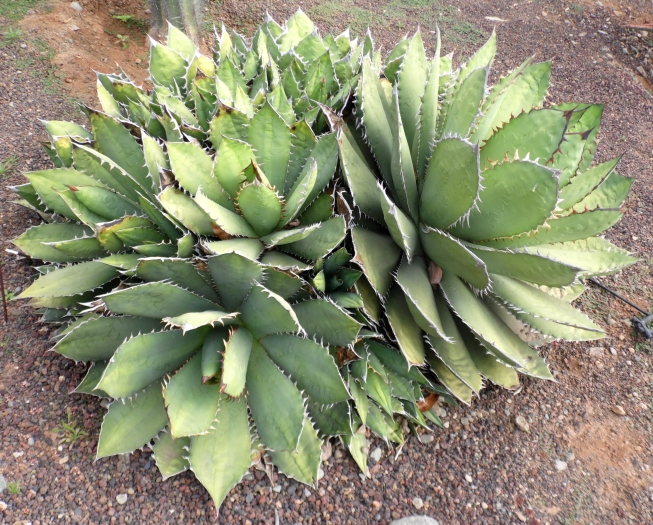Chalk Agave
(Agave titanota)
Chalk Agave (Agave titanota)
/
/

Krzysztof Ziarnek, Kenraiz
CC BY-SA 3.0
Image By:
Krzysztof Ziarnek, Kenraiz
Recorded By:
Copyright:
CC BY-SA 3.0
Copyright Notice:
Photo by: Krzysztof Ziarnek, Kenraiz | License Type: CC BY-SA 3.0 | License URL: https://creativecommons.org/licenses/by/3.0 | Uploader: Kenraiz | Publisher: Wikimedia Commons |


















Estimated Native Range
Summary
Agave titanota, commonly known as Chalk Agave, is an evergreen succulent perennial native to rocky cliffs and slopes in the semi-arid regions of Oaxaca, Mexico. It typically reaches 1-2 feet in height and 2-3 feet in width, forming a solitary rosette of broad, whitish-green leaves. The leaves are adorned with variable spines and measure 1-2 feet long and 5 inches wide, often being narrower at the base and widest near the tip. Mature plants may occasionally produce offsets and, after several years, send up a dramatic flower spike ranging from 3 to 6 meters tall with yellow flowers. As a monocarpic species, flowering once signifies the end of the plant’s life cycle.
Chalk Agave is valued for its striking foliage and architectural form, making it a popular choice for rock gardens, xeriscaping, and as a container specimen in colder climates. It is hardy to USDA zones 9-11 and has earned the Royal Horticultural Society’s Award of Garden Merit for its ornamental qualities. While it can tolerate temperatures as low as −3 °C (27 °F), it thrives best in a sheltered location free from severe frosts. This plant requires full sun exposure and very low to low water once established, preferring soils with excellent drainage. Gardeners should be aware of potential issues with scale insects and chlorosis due to magnesium deficiency.CC BY-SA 4.0
Chalk Agave is valued for its striking foliage and architectural form, making it a popular choice for rock gardens, xeriscaping, and as a container specimen in colder climates. It is hardy to USDA zones 9-11 and has earned the Royal Horticultural Society’s Award of Garden Merit for its ornamental qualities. While it can tolerate temperatures as low as −3 °C (27 °F), it thrives best in a sheltered location free from severe frosts. This plant requires full sun exposure and very low to low water once established, preferring soils with excellent drainage. Gardeners should be aware of potential issues with scale insects and chlorosis due to magnesium deficiency.CC BY-SA 4.0
Plant Description
- Plant Type: Succulent
- Height: 1-2 feet
- Width: 2-3 feet
- Growth Rate: Slow
- Flower Color: Yellow
- Flowering Season: Summer
- Leaf Retention: Evergreen
Growth Requirements
- Sun: Full Sun
- Water: Very Low, Low
- Drainage: Fast
Common Uses
Bee Garden, Bird Garden, Drought Tolerant, Fire Resistant, Hummingbird Garden, Low Maintenance, Potted Plant, Rabbit Resistant, Rock Garden, Street Planting
Natural Habitat
Native to rocky cliffs and slopes in the semi-arid regions of Oaxaca, Mexico
Other Names
Common Names: Rancho Tambor Agave Chalk Agave
Scientific Names: , Agave titanota,
GBIF Accepted Name: Agave titanota Gentry